#Sidisi Brood Tyrant
Text

Sidisi, Brood Tyrant full card alter that I just finished! This one was fun, all those tiny snake scales are oddly relaxing to fixate on haha
#mtg#magic the gathering#mtg alters#full card art#altered art#custom mtg card#sidisi brood tyrant#magic#snakes#alters by n8
18 notes
·
View notes
Text

Sidisi, Brood Tyrant by Zezhou Chen
#Magic the Gathering#MtG#MtGKTK#Arena Release#Khans of Tarkir#Tarkir#Sidisi Brood Tyrant#Naga#Fantasy#Art#Zezhou Chen#Wizards of the Coast
24 notes
·
View notes
Photo

So broody
22 notes
·
View notes
Photo

Sidisi: Brood Tyrant - Zezhou Chen
73 notes
·
View notes
Text
In an Effort to Archive my Decks here is every list.
Sai, Master Thopterist - MonoU Thopter Artificing
Daretti, Scrap Savant - MonoR Artificing
Lathliss, Dragon Queen - MonoR Dragons
Oviya Pashiri, Sage Lifecrafter - MonoG big n tall
The Council of Four - Azorius Profiteering
Tajic, Blade of the Legion - Boros Damage Redirection
Tasha/Sygg - Dimir Theft
Lazav, Dimir Mastermind - Dimir Mill
Wilhelt, the Rotcleaver - Dimir zombie tribal
Vadrik, Astral Archmage - Izzet Spellslinget
Jori En, Ruin Diver - Izzet Cantrips
Athreos, God of Passage - Orzhov Aristocrats
Obzedat, Ghost Council - Orzhov Lifegain
Prosper, Tome-Bound - Rakdos Treasures
Chainer, Nightmare Adept - Rakdos Reanimator
Prime Speaker Zegana - Simic Counters
Ixhel, Scion of Atraxa - Abzan Poison
Kathril, Aspect Warper - Abzan Keyword Counters
Kestia, the Cultivator - Bant Auras
Roon of the Hidden Realm - Bant Fair-er Flicker
Aminatou, the Fateshifter - Esper Topdeck
Sharuum the Hegemon - Esper Artificer
Zurgo and Ojutai - Jeskai Combat Control
Sidisi, Brood Tyrant - Sultai Self Mill
Riku of Two Reflections - Temur Hug
Maelstrom Wanderer - Temur Topdeck
Horde of Notions - 5c Elementals
Ramos, Dragon Engine - 5c Casting Tribal
The Ur-Dragon - 5c Dragons
7 notes
·
View notes
Text
Krenko’s Guide to Creature Types: Naga

The most beautiful woman in all of MTG, by James Ryman
What is a Naga (flavorfully)?
In Asian mythology, Nagas are a type of divine being that are somewhere between human and serpent, depending on the individual myth. Some are basically humans with serpent iconography, others are basically snakes that happen to be able to talk. They’re generally pleasant and benevolent to humans, and they usually have some sort of power over water.
In Magic: the Gathering, Nagas are snake people (also called ‘sneeple’) with arms and long tails, enabling them to give even better hugs than normal snakes. Female nagas have no breasts, though as they wear similar fashion to humans their clothing often gives the illusion of breasts. Imoti has extra arms for unknown reasons.
Nagas are primarily native to Tarkir and Amonkhet, and while the species is roughly the same, Tarkir Nagas seem to be a lot meaner.
What is a Naga (mechanically)?
Naga is a race creature type, usually attached to a class. Nagas are primarily blue or green, save for the one White Naga that doesn’t actually exist, and the couple of Zombie Nagas, which are of course Black. Other than that, Nagas don’t have any sort of unifying mechanic. The closest they have is the Exploit mechanic, which is the Sultai mechanic rather than a racial specific one.

Can I make a Naga deck?
Unclear!
For a sixty card deck, there’s certainly enough decent Nagas that you can build a sixty card deck with competent creatures, turn them sideways, and put up a threat against other casual decks. There’s not quite a critical mass of Nagas to start making actually good decks out of them, but it’s basically fine.
In Commander, Sidisi, Brood Tyrant, is a fun and interesting commander whose ability works well with Exploit and many other incidental Naga abilities. With only 37 other Nagas in Sidisi’s colors, you’re going to be a bit tight getting good creatures, but the deck can still be plenty of fun. Many Nagas reward self-mill strategies, others are happy to use Exploit to sacrifice the Zombie tokens Sidisi makes, and others are just good in their own right. It’s not going to be Earth-shattering, but it’ll be fine for a casual table, and the various weird synergies can be a lot of fun.

Is Naga a good creature type?
Naga… means Snake. Yes, there are distinct mythological beings called Nagas, and I understand the desire to distinguish them from snakes, but there’s one major problem with that from a gameplay mechanic, and that’s the Orochi. Orochi, the sneeple from Kamigawa, are creature type Snake and aren’t really distinguishable from the Naga in any reasonable way. Some Orochi have legs, but many don’t. Orochi women have boobs, but that’s actually more of a Naga trait than a Snake trait. Orochi have four arms instead of two, but that’s definitely not a Snake trait in any sense of the word.
The reason this matters so much is that Orochi have a number of cards that care about the Snake creature type. Naga could easily have joined the Orochi to encourage Snake decks without much power level concern (as Snake isn’t a particularly strong type right now), but instead they have their own type that’s, for the most part, useless.
The Naga debate has happened plenty, but ultimately I think the general agreement is that adding creature type Naga was a bad idea and they should all have been Snakes. I just wish Wizards would be willing to errata away their bad idea. It’s not like they haven’t errata’d plenty of other types over the years.
#Krenko's Guide#Naga#Snake#I am seriously in love with Naga Vitalist#Someone please tell me she survived the Hour of Devastation
38 notes
·
View notes
Text
The sad truth of life is that I will never slay as hard as Sidisi, Brood Tyrant

4 notes
·
View notes
Text
I enjoy playing EDH/Commander because I love assembling Rube Goldberg-esque contraptions out of Magic cards, watching my horrible janky creations chug along and sow chaos as they go.
Today I think I assembled my least efficient extended combo to date (While 'Goldfishing', I doubt anyone would let me get away with this, especially my play group):
Sidisi, Brood Tyrant on the field (Commander), plus some zombie tokens
Ashnod's Altar on the field
Play Rooftop Storm
Play Havengul Lich for free
Sacrifice a zombie token to Ashnod's Altar to pay for 2 activations of Havengul Lich. This is where the fun begins.
Cast Stitcher's Supplier and one other creature from the Graveyard for free (Havengul Lich + Rooftop Storm).
Sticher's Supplier mills 3 on ETB, possibly makes a zombie token (Sidisi, Brood Tyrant).
Sacrifice Stitcher's Supplier for mana again, pays for 2 Havengul Lich activations and mills 3 again (another possible Sidisi trigger).
Recur Stitcher's Supplier (mill 3, maybe get a zombie) and another creature.
Repeat steps 3 and 4 ad nauseum until you've burned through your deck and amassed a stupid amount of zombies.
(Alternately, once you've recurred your entire stable of creatures, continually sac/recur any creature and net 1 mana each time.)
From there I had a few options; Villainous Wealth in hand, Increasing Confusion in the Graveyard (sac my whole board for X mana), and Laboratory Maniac in the Graveyard (mill to 0, force a draw with one of several sources). Since this was all still my turn, I could probably have safely attempted all 3 (again, 'goldfishing' so no opponents but still. lol. lmao even.)
#sable talks about games#magic the gathering#mtg#edh#mtg commander#this post is for nobody lol#cementing my reputation as a 'Johnny'
1 note
·
View note
Text
Who would win: a Scute Swarm exponentially growing and a Ruin Crab milling you out with every land drop, or a Sidisi (Brood Tyrant, from Khans) creating a zombie and a Dreadhound pinging them for every creature card milled
Spoilers, Sidisi (played by me) won. MTG Tip: Milling your opponent is almost always a bad idea
0 notes
Text
Bronze to Mythic: Khans of Tarkir, draft #5
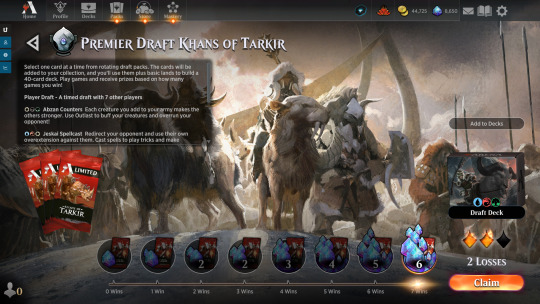

7-2, should have been 7-0, but in any case, we back, baby!
I've been on a really bad losing skid, barely above 50% win rate for my last like 15 drafts, when my lifetime average on Arena is close to 65%. This was the first draft in a long time that felt like I navigated the draft well, my deck was great, I played well, and things just generally broke in my favor. I had honestly forgotten what this felt like. And 7-2 got me to platinum!
(Now, I wish I could have capitalized on this feeling instead of everyone in my family being sick for the next two weeks.)
Pack 1, pick 1 Snowhorn Rider over Dig Through Time, Incremental Growth, Kin-Tree Invocation and Mardu Charm. It's unexciting, but with no clear direction, Rider is the most powerful card that leaves me the most open. Pick 2 a pretty easy Heir of the Wilds over Jeskai Windscout, Temur Charger, and Thornwood Falls. I think it's the best 2 drop, and goes really well with my first pick. Pick 3 Swiftwater Cliffs over Smoke Teller, Glacial Stalker, Efreet Weaponmaster and Jeskai Charm. Pick 4 Alpine Grizzly over Chief of the Scale and Abzan Guide. the pick 5 Bear's Companion gets the plan rolling. Pick 6 Hooting Mandrils, nice to have a cheap 4-power creature. Pick 7 Embodiment of Spring over like Summit Prowler, whatever, I'm not playing any of these cards. Pick 8 Smoke Teller, 2 drops are good. Pick 9 Whirlwind Adept, which is awesome in Temur. Pick 10 Canyon Lurkers, it will make the cut as a 5 power morph. I'm liking where I'm at after pack 1. Savage Punch over everything, lets pick up some Awaken the Bears to smash face, and lets just always have Ferocious.
Pack 2, Pick 1 Arc Lightning over Secret Plans, Winterflame, and Snowhorn Rider. Arc Lightning is really good, but I think it is close with Rider in Temur. It's more of a Jeskai card, I think. Pick 2 another Heir of the Wilds over Snowhorn Rider. Hate passing all these Riders but Heir is premium. Pick 3 *another* Heir of the Wilds! Love it! Pick 4 War-Name Aspirant over Glacial Stalker, just another high quality 2 drop, and it's gonna be a 3/2 most of the time as I'm pretty likely to trigger Raid. Pick 5 Ponyback Brigade over nothing. Pick 6 Thornwood Falls, perfect. Pick 6 another Hooting Mandrils, which is looking pretty good in this deck. I'm going to trade off these 2 drops a lot so having two should be pretty good. This pack petered out from here, getting a third Mandrils which would be ambitious to play, but I did pick up a Dragonscale Boon 10th. I am pretty happy where I'm at, but I'm not happy that nothing is wheeling, and I am going to need a little help in pack 3.
Pack 3, pick 1 a sad Temur Charger over Zurgo Helmsmasher and Armament Corps, two cards that have been awesome for me and that I can never cast in a million years. Pick 2 a sad Longshot Squad over Rakshasa Deathdealer and Secret Plans. Pick 3 another sad Temur Charger over Sidisi, Brood Tyrant. My 2 drop slot is really stacked though. Pick 4 slam Savage Punch. Finally! Pick 5 Awaken the Bear over Alpine Grizzly (and another Armament Corps), I'm hoping Grizzly wheels. Pick 6 Canyon Lurkers because 5 power. Pick 7 another Awaken the Bear, perfect! I get Glacial Stalker and Alpine Grizzly on the wheel.
The games were fast and brutal. Awaken the Bear was MVP, with this fast start, and with 4/2 bears screaming "Chump block me" I got some really good blowouts. Not to mention how deathtouch works with trample got me across for lethal on more than one occasion.
I was 6-0, and my first loss should have been my 7th win. I missed that Longshot Squad gives all creatures with counters Reach, and I had a Bear token with the Dragonscale Boon counters on it in the face of their Venerable Lammasu. I had Squad in hand for multiple turns thinking it was too late to cast it, outlast it, and block. I thought I was dead, I attacked just to check if they would block, and then as my Bear was being chumpblocked, I saw it.
My second loss was disappointing, my 2 drop army got stonewalled by a pair of Unyielding Krumars (first strike bricking my deathtouchers) and Chief of the Scale, then I got completely blown out by Roar of Challenge.
Should have been 7-0, but a trophy is a trophy. I love this set!
0 notes
Text
Zombie EDH
I'm trying to build a zombie commander deck, used to have a Gisa and Geralf deck, but now I'm stuck. Can't decide who to use, Varina, Lich Queen or Sidisi, Brood Tyrant.
Help with deciding which to use would be very helpful.
#magic the card game#magic the gathering#edh#commander#zombies#sidisi brood tyrant#varina lich queen
20 notes
·
View notes
Text
Sidisi's Living Death EDH Update
List can be found here ---> http://tappedout.net/mtg-decks/sidisis-living-death/ Only a small change to report today. Drops: Mystic Snake Adds: Carrion Feeder Mystic Snake is a very powerful card, but for this specific deck it ends up spending more time sitting in hand than doing it's job. This build of Sidisi is aggressive, it's very much a tap out each turn style of deck. So holding up 2 green and 1 blue (when we are already very light on blue mana to start with) is hard to do. Carrion Feeder on the other hand is a great sac outlet, which this deck wants so badly. It ups our devotion to black for Gary as well as being able to get infinitely big when combined with a persist creature and Mikaeus, then you can sac it to Jarad. Over all it synergies perfectly with what this deck wants to do.
3 notes
·
View notes
Text
How to Actually Play Magic: The Gathering
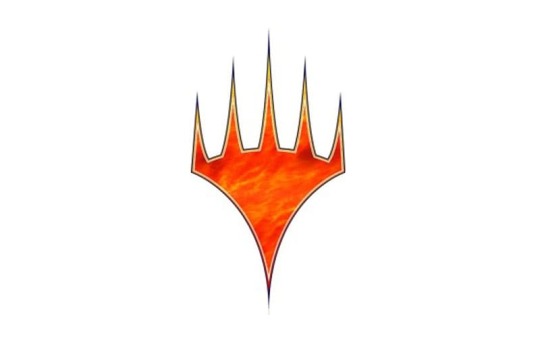
Magic: The Gathering (MTG, or just Magic) is the first and one of the most popular trading card games in the world. Described as the chess of card games, you can go as complex as you want (even make a computer) or have as much fun as you want, diving into the multitudes of worlds, creatures, and characters to express yourself.
But first you need to know how to play.
Lots of guides tend to be overly simplistic, so here I’ll try to go really in-depth in the rules while still maintaining an introductory tone. I will also try to provide as many pictures of relevant cards as possible to expose you to the vast array of effects cards may have, and how they interact with what I’m currently discussing.
1. The Colors of Magic

The most defining part of Magic are the five different colors. Each has its own flavor, playstyle, advantages, and disadvantages. You can combine different colors in your deck to have access to interesting combos and to balance out your deck’s weaknesses. Different color combinations also have their own specific flavor, often embodied by groups such as the guilds of Ravnica.
White: This is the color of unity, healing, and order. Cards in this color will often gain you life, protect your creatures from damage, tax or outright prevent your opponents from doing tricky things, and make armies of small creatures that together make mighty fighting forces. It is also associated with artifacts, enchantments, and exiling.
By the way, I will be defining Magic terms as they come up, like so.
Token: A representation of a creature, artifact, or something else. You can use it like a card while it exists, but it will vanish when it leaves the battlefield. (the rest of these terms will come up soon.)
Exile: Originally called “removed from the game”, exile is a zone that is inaccessible to most cards. It makes sure your opponents’ creatures go away forever. Sometimes, creatures go to exile and come right back to get extra enter-the-battlefield effects, known as blinking.
If you see something that isn’t immediately defined, just keep it in mind. Chances are I’ll cover it in a later chapter.
Blue: This color is related to knowledge, water, and the cold. You’ll get to draw lots of cards, but your creatures will be lacking. Instead, you will have access to powerful spells that bounce, freeze, or steal your opponents’ creatures and even give you extra turns. Quelch your opponents’ attempts with counterspells. It also has affinity for artifacts.
Black: This color represents death, disease, and ambition. Full of evil kill and discard spells, you will have access to your own army of zombies, vampires, and demons. You will also be able to do powerful things, but often at the cost of cards, creatures, or even your own health. In the words of Dark Confidant, “Greatness, at any cost.”
Red: This is the color of passion, fire, and explosive power. Many of the direct damage spells, including the iconic Lightning Bolt, are Red, as well as aggressive, fast creatures and multiple combats. You will have an extreme upper hand in your first few turns, but will quickly run out of gas if you don’t use another color to keep up on card draw. Red also brings with it mighty dragons and world-morphing chaotic effects.
Green: The color of nature, Green is similar to white in its abilities to heal, create tokens, and destroy artifacts and enchantments. However, Green has a wild side and is full of giant beasts, swarms of bugs, and rapid evolutions. It also brings out lands quickly and makes tons of mana.
2. Dissecting a Card

Sidisi is a popular character that hales from the plane of Tarkir. She’ll be helping us as a prime example of what a card looks like. There’s a lot to take in, but we’ll start from the top and work our way down.
First is the border (yes, from the very top!). It seems silly, but there are actually a few different borders that mean different things. A vast majority of cards have the regular black border. You may also see cards with white borders - these tend to be older cards, but they’re just as good as the black bordered ones. Silver borders come from the Un-sets, a series of joke sets full of wacky mechanics and inside jokes. None of these cards are tournament legal, but you’re free to have fun with them with your friends. Gold-bordered cards will also have a different back, and were printed as a part of tournament-winning decks back in the day. These are not tournament legal, but since they are often cheaper than their “real card” counterparts, people will use them in casual decks.

Next is the name. “Sidisi, Brood Tyrant” is the full, English name of this card. Each deck can only have up to 4 copies of any single card (there are very important exceptions to this I will cover in the next chapter). There are also a few cards which specifically reference others by name.
To the right of that is the mana cost. In this case, we need to use one black mana, one green mana, one blue mana (each represented by their respective symbol) and one mana which can be of any color, or even colorless, represented by the 1 in the circle. We’ll find out how to get mana in the next chapter as well. As a side note, many cards will consider the mana value (formerly, converted mana cost), which is just the total cost of the card as a number. For Sidisi, it’s four.
Beneath that is the art.

Arguably the most important part of any card, Magic’s art is what really sets it apart from other games. People fall in love with specific cards for their dramatic poses, mighty beings, and stunning vistas. The art brings character to every card, and ties flavor and function beautifully. This is the best way to express yourself, and find what you really like about Magic.

Next is a thin bar called the typeline. This will tell you first what type of card it is - either a land, creature, artifact, enchantment, planeswalker, instant, sorcery, or tribal (or some combination!), which dictate how you use the card, and what other cards interact with it. Card types can be divided into permanent, which go on the battlefield once played, and nonpermanent, which you play for a single effect and immediately go to your graveyard. There are also some supertypes. Sidisi herself is Legendary, meaning she represents a specific character from Magic lore. This also means you can only have a single copy of her on the battlefield at any one moment; if you somehow get another, you’ll have to sacrifice one. Basic is another important supertype we’ll cover soon.
On the other side of the hyphen is the subtype - this is almost exclusively used for creatures to tell you what tribes they belong to. Sidisi herself is a Naga and a Shaman, and will thus interact with cards that care about that (these are often called tribal effects; for example, “Elves you control get +1/+1″). From Trilobites to Trolls, the creatures of magic are a diverse crowd.
Finally comes the set symbol, that strange orange shield thingy to the right. This tells you two things: the set the card comes from, and the rarity. This specific symbol represents the set Khans of Tarkir, so booster packs from that set may contain Sidisi. Rarity comes in 5 different colors.

Black: Common (Simple, often weak)
Silver: Uncommon (May have cool mechanics)
Gold: Rare (More powerful and complex)
Orange: Mythic Rare (The most powerful and complex)
Purple: Special (This is only used in situations such as Time Spiral, where they reprinted cards in the old border)
The rarity often (but not necessarily) corresponds to power level. It’s better to think of it as a ranking of design complexity. Newer Rares and Mythics will also have that shiny, elliptical sticker near the bottom, which simply guarantees the authenticity of the card.

The bottom half of the card is dominated by the text box. This will tell you the effects and abilities of the card. Sidisi has two abilities: one that triggers whenever she enters the battlefield or attacks, and one that triggers whenever a creature card is put into the graveyard from your library (on modern cards, this is called milling). We will go over abilities later.
Notice how Sidisi aligns with her colors. As a Naga, she is Green. Her zombie tokens are characteristic of Black, and tokens are generally Green as well. Milling is a Blue ability, and putting creatures in the graveyard to bring back to life is definitely Black.
The text box is also home to flavor text, the italicized text beneath the rules. This will often be a little blurb or quote relating to the flavor of the card. Consider it an extension of the art.
Creatures will also have that rectangle to the bottom right, called the Power and Toughness. The first number is the power (how hard it punches) and the second is the toughness (how hard of a punch it can take). This is relevant for combat and we will cover it extensively later.
Finally come all those funny symbols at the very bottom. This will include the collector’s number (199/269), the set (KTK = Khans of Tarkir), the artist (Karl Kopinski) and the copyright.
3. Lands
Lands are by far the most important component of your deck. They are what generate the mana you need to cast your spells, and dictate the colors of spells you can play.
You can play one land per turn - just plop it from your hand onto the battlefield. They have no mana cost, and thus the top right is blank.
The Basic land is the prime exception to the four-card limit, as you can have as many as you want in your deck. The Basic supertype also interacts with several cards, such as ones which let you get more from your deck onto the battlefield.
The 6 basic lands are Plains (white), Island (blue), Swamp (black), Mountain (red), Forest (green), and Wastes (colorless, only used in decks such as Eldrazi Tron, and are often not included).

This cycle comes from Lorwyn, a set based in Gaelic mythology.
All Basic lands come with the implied rules text that they can tap to create one mana of their respective color, and as such will often have the cinematic mana symbol instead.
Tap: A common cost on a permanent to activate an ability. Turn the card sideways to tap it. It will stay tapped until your next turn, when it will untap during your untap phase (more on that later). A tapped card can’t be tapped again, and a tapped creature can’t block.
Some lands, especially those that can make different colors, will enter the battlefield tapped, so you’ll have to wait an extra turn to use them. Other lands might only create colorless mana (represented by a number on older cards and a diamond on newer cards), so they’re less useful for casting spells, but will have interesting abilities, such as:

This Mutavault can turn into a creature for just 1 mana, which you can use to attack and block with. (Pop quiz: see if you can recognize each part of the card!) There are dozens more examples that do everything from draw you cards to destroy your opponents’ pesky lands.
But what exactly does it mean to create a mana? Well, really, it gets added to your mana pool, as you may have noticed on the Mutavault. This is an arbitrary place where all your mana goes so that you can spend it. This isn’t often relevant, because you’ll mostly tap your lands while casting spells and the mana will immediately be used, but there are a few scenarios where it might be useful. For example, someone targets your land to destroy it because they don’t want you to have the mana open to kill something they’ll play next. Just tap your land to keep a mana “floating”. However, all the mana in your pool will automatically drain out each time you change phases (more on those later).
Tapping lands for mana is an ability, but since it’s a mana ability, it won’t use the stack, so you can use them just about whenever. More on the stack later as well.
Most decks will be around one-third lands, with more or less depending on how low the average cost of cards you have are. The less colors you run, the less cards you have at your disposal, but the more flexible your mana base can be - more colors often use lands that enter tapped and are inconsistent at drawing the colors they need.
Have fun experimenting with your mana base, especially in casual formats. In more competitive formats, lands are actually the most expensive cards! The top lands are called the shocklands, fetchlands, and original dual lands - the last of which are several hundred dollars each.
4. Permanents
Besides lands, just about every other card you play is considered a spell when you cast it (you’ll see this on cards such as Counterspell). However, for the sake of clarity, I’ll be using “Permanent” to refer to anything that goes directly on the battlefield once it resolves and “Spell” to refer to single-use cards.
Of the card types mentioned above, permanents include lands (which we just covered), creatures, artifacts, enchantments, and the mighty planeswalkers. I’ll include a visual example of each as we go.
Creatures are your basic way of winning the game. They can attack your opponent to take down their life total, but might also have interesting abilities that make them more valuable as repeatable spells than combatants.

Incubation druid is a great example of both: she starts off as an additional land, giving you more mana quicker to play your other cards. With 0 power, she’s useless as an attacker. However, her Adapt ability lets her grow into a formidable 3/5, so you can attack and block with her much more effectively later in the game. Notice the curved arrow symbol that represents tapping.
+1/+1 Counter: This is a permanent buff to your creature, giving it an additional power and toughness each. Counters in general can come in many forms: -1/-1 counters are self-explanatory, but ability counters such as a Flying counter give your creature a new keyword. Other counters, such as Lore and Filibuster, keep track of certain things for you. Always bring a few dice with you to every game, as you’re sure to want to track some sort of counter.
Creatures enter the battlefield with summoning sickness, which means they can’t attack or use any ability that requires them to tap until your next turn. Creatures also get summoning sick when they change control. A creature with Haste, a keyword ability, lets you ignore this, and is often found on red creatures.
Artifacts, lore wise, are artificial, sterile creations of wizardry, and as such, almost never correspond to a color. They may imitate the effects of a certain color, but to prevent other colors from having easy access to it, they will often be overcosted. A common type of artifact is colloquially known as the mana rock, as it generates mana. There are many cards that interact and enhance artifacts.

Hedron Archive is a typical mana rock, costing four mana of any color and boosting your mana generation ability by two. Later in the game, if you already have more than enough lands, you can cash it in for two mana to draw some more cards. Notice the distinct metallic border.
Artifacts often combine with Creatures to form Artifact Creatures, or less commonly with Lands to create Artifact Lands.
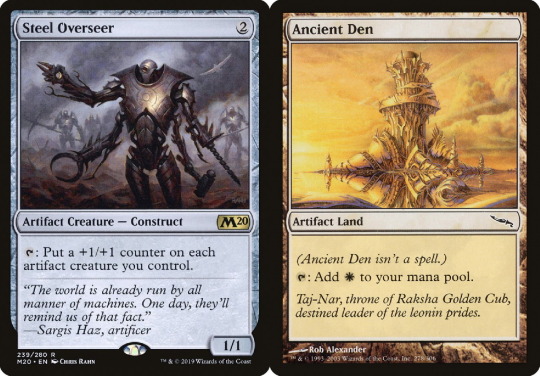
Artifacts can also come on the form of Equipment, which will give an effect when equipped to a creature. This often comes in the form of a buff to its power and toughness, but can also include adding keywords and other cool abilities. You’ll need to equip it by paying a cost, and can pass equipment around between any of your creatures. This can result in some funny mental images, such as a cat wearing a suit of armor and wielding three swords!

Enchantments are similar to artifacts in that they sit on the battlefield and have an effect, but they will have color. Also, Green and White excel at “cleansing” both by destroying them, but Red is only good at blowing up artifacts - after all, an ogre with a mace can smash a rock, but not a mystical spell.
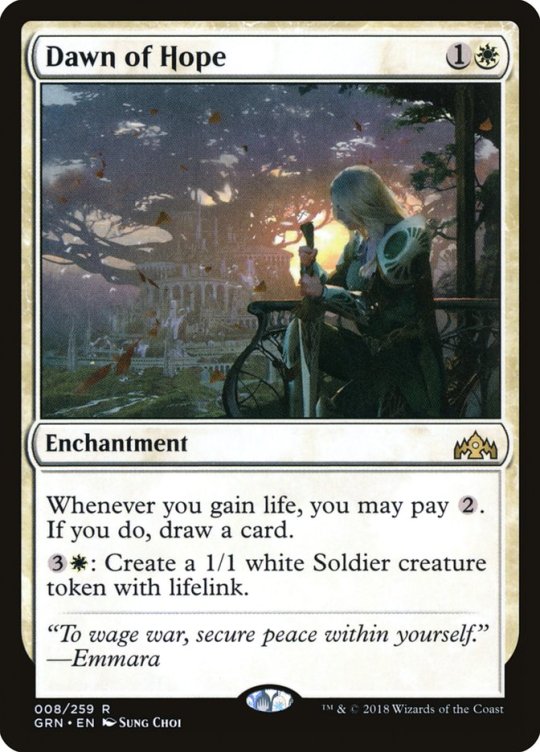
Some enchantments have the subtype Aura. This means you cast them targeting a specific permanent, and they will enter the battlefield attached to that permanent like a piece of Equipment. These, however, can’t be moved around, and will fall off and go to the graveyard if the thing they enchant ever leaves the battlefield. Auras will often buff creatures, but can also subdue permanents or boost a land’s mana production.

Planeswalkers are the newest and arguably the most powerful of the permanents. They represent the primary characters of MTG lore, beings who have incredible magical prowess and can teleport from plane to plane. They are (as of yet) all legendary, and thus you can only have one of each at a time on the battlefield.
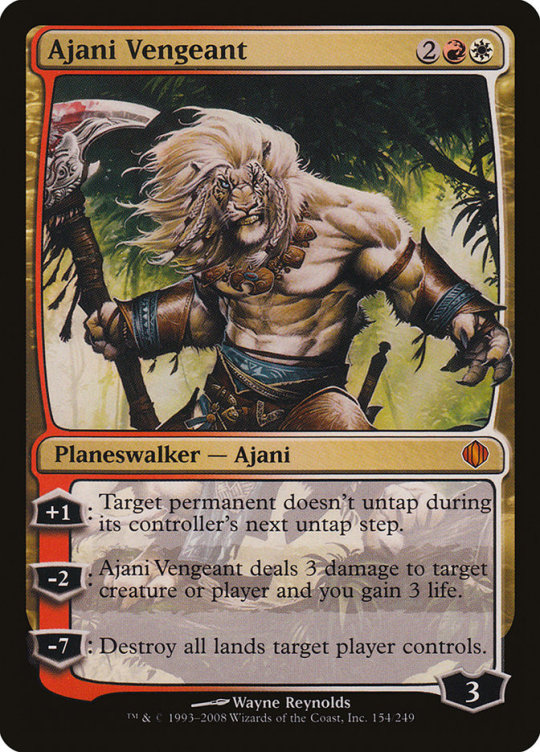
They look pretty weird, don’t they? Instead of a power and toughness, they have a loyalty in the bottom right. Each planeswalker will enter the battlefield with that many loyalty counters on it. You can activate one of its abilities on each of your turns by adding or subtracting the indicated loyalty. Once a planeswalker is at zero, it dies and goes to the graveyard (or rather, gets fed up with your mishandling and teleports away, as per loyalty flavor). Planeswalkers can also be killed by spells that specifically target them, when they’re dealt damage, or when they’re attacked by creatures. Their last ability is often incredibly powerful, and is called an “ultimate”. Newer planeswalkers sometimes also have static abilities.

Planeswalkers are not creatures, and can’t attack or block. That being said, there are some planeswalkers that can turn into creatures.
Permanents are very useful, as they stick around and provide value turn after turn. Many strategies revolve around certain tribes, or using artifacts. Creatures are the main way to get damage through to your opponent to win the game. And planeswalkers have powerful abilities, requiring an answer from your opponent to stay in the game.
5. Spells
As stated above, all nonland cards are technically spells when cast, but here we will talk specifically about Instants and Sorceries. We will also define timing, as instant- and sorcery- speed is something we will discuss often when looking at casting spells, activating abilities, and using the stack.
Sorceries are your basic single-use card. Pay their cost, they’ll resolve, and you’ll get their effect once before they go to the graveyard.

Something I haven’t brought up yet is when you can play cards. We’ll go over the turn structure more in depth, but for now, know there’s a beginning step, a main phase, a combat phase, and a second main phase. You can play any of the previously mentioned cards, including sorceries, and activate planeswalker abilities, whenever it’s your main phase and the stack is empty.
The Stack: Whenever you cast a spell or activate a non-mana ability, or a triggered ability triggers, it will go on the stack. Things on the stack resolve last-in, first-out.
Instants are just like sorceries, but you can cast them at any time you have priority. This means they can go on the stack above other spells, which allows them to interact with other spells. Activated abilities can also be activated whenever, except for planeswalker abilities and those which specify otherwise.
Priority: When you have priority, you will have an opportunity to cast spells, play lands, and activate abilities. Everyone gets priority every phase, and it starts with the active player (whoever’s turn it is) and is passed around in turn order.
Whenever something goes on the stack, priority is passed around as well. Once each player has passed priority, it resolves and priority is passed once again for the next thing.
You can hold priority to cast multiple spells in a row.
Here’s a quick example to see how spells, abilities, and priority all interact on the stack:
Johnny and Timmy are playing each other, and it’s Timmy’s main phase. Johnny has a 0/2 Incubation Druid.
Timmy plays a Bala Ged Scorpion, which goes on the stack. Priority is passed around and it resolves. Its triggered ability goes on the stack, and Timmy targets Johnny’s Incubation Druid, since its power is 0, less than 1.
Since the ability is on the stack, Timmy gets priority and passes it to Johnny. In response, Johnny casts Burst of Strength, maintains priority, and casts a second Burst of Strength. Now priority passes between them for both, and they both resolve. Incubation Druid is now a 2/4.
Priority passes for Bala Ged Scorpion’s ability, but since the Incubation Druid now has more than 1 power, the ability does nothing and fizzles.
Fizzle: A spell whose target is no longer legal does nothing when it resolves. This is colloquially called fizzling.

Assuming he had the mana for it, Johnny could also have activated Incubation Druid’s Adapt ability in response to the Bala Ged Scorpion, making it a 3/5 and also letting it survive.
There are lots of cool things you can do with the stack, such as making slick plays to foil your opponents’ spells or to copy big spells for massive value.
Some permanent cards have Flash. This is a keyword ability that lets you play the card as if it was an instant. Teferi, Mage of Zhalfir is the quintessential Flash card, as it also gives your other creatures flash and prevents your opponents from playing at instant speed.

6. Where are We?
I’ve been throwing around terms such as Graveyard and Battlefield, so what exactly do these mean? Well, these are all zones. We’ve already looked at one zone - Exile. The Stack is also a zone.
A zone is a place where cards can exist. They may have abilities that work while in that zone, most often on the battlefield. Public zones are where all the cards are known. This includes the Battlefield, the Graveyard, and Exile.
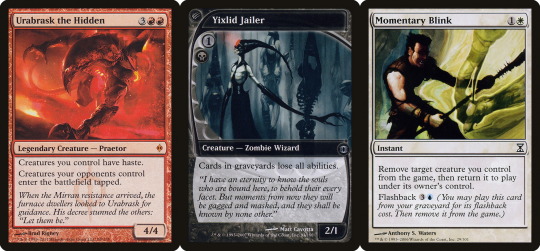
Urabrask’s ability only works while he’s on the battlefield, and only creatures you control on the battlefield would get haste - after all, those are the only ones who can use it, anyways. Yixlid Jailer takes away abilities from cards in graveyards, so Momentary Blink would not have Flashback while it’s there. Momentary Blink also exiles a creature (using the old wording of “removed from the game”) and brings it back, known as flickering.

Private zones are anywhere where cards are not public information. This includes your hand and your library. Thoughtseize, and other similar hand disruption spells, let you take a peek at what your opponent has. Loads of cards like Armillary Sphere let you search your library for cards. Others may reveal the top card of your library, or let you look at the top few.
It’s also possible to have “hidden” cards in public zones. Willbender feature the Morph mechanic, which lets you cast it face-down as a 2/2 creature. This means your opponent won’t know what it is until you turn it face up, but you will. Other effects might put cards face-down in exile, where you could cast them.
Whenever a card changes zones, it becomes a new “object”. That means all counters, equipment, and auras fall off, and it is no longer being targeted by anything that was targeting it before. A classic use of this rule is flickering a creature being targeted by a kill spell - even though it comes back to the battlefield, it is a new object and is thus no longer being targeted by the kill spell. The spell will fizzle and your creature will be safe.
7. Starting the Game
Ok. So you’ve got a basic understanding of all the cards and the different locations. How do you get started actually playing?
There are lots of ways to play the game, but I’ll start out with the most common: a 1v1, best of 3 duel. This will also get a little bit into deckbuilding, but there’s a lot more on that later.
Most 1v1 decks will be 60 cards. In fact, this is a lower limit, and you can have as many cards as you want, but it’s convention to stay at 60 cards to maintain consistency. In a best of 3 match, you will also have a sideboard - 15 or less cards that may target specific strategies such as graveyard decks or artifact decks. After your first game and seeing what your opponent is playing, you’ll be able to switch out cards in your deck for the right silver bullets for games 2 and 3.

Common sideboard cards against Burn, graveyard, and artifact strategies.
If you’re playing a casual game with a friend, feel free to omit the sideboard, but it’s a staple part of competitive play and is a fun way to personalize decks in strictly defined metagames.
Now that you’ve got a deck (and presumably, a friend with a deck as well) shuffle up. Cut your opponent’s deck by putting the top half on the bottom (a customary ritual to prevent cheating) and let them cut yours. Figure out who’s going first by rolling some dice (whoever wins gets to choose, but generally going first is preferred), and draw seven cards.
You may not like your hand for several reasons. Maybe you have too many lands, or none at all. Your lands might all produce the same color of mana instead of all the colors you need, or you might have only highly-costed spells and nothing to do on your early turns.
No problem, just shuffle it back in and draw seven more. This is called mulliganing. You can do this as many times as you want, but don’t be too hasty, because once you find a hand you like, you’ll need to put one card from your hand on the bottom of your library for each time you mulliganed.
Now it’s time for your first turn. But before we really get playing, let’s look at the structure of a turn.
8. Phases of a Turn

credit to u/paper_alien
From this fancy diagram, we can see that your turn is broken down into roughly three different parts. I’ll be including examples of cards that interact with each phase. First is the beginning phase.
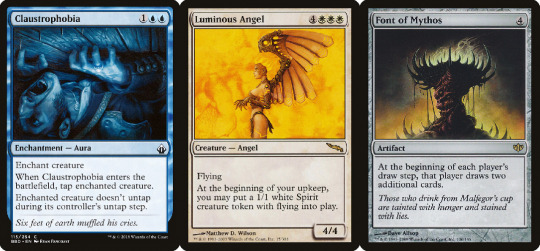
Your untap step is right at the start, when all your permanents untap. Simply turn them right-side up. Claustrophobia would prevent one of your opponents’ creatures from untapping, rendering it useless as an attacker and blocker, as well as preventing its tap abilities from being used. No player gains priority during the untap step, and play immediately proceeds to the upkeep step.
Normally, nothing happens here, unless an ability triggers. For example, the Luminous Angel gives you a 1/1 token on your upkeep. Players will get priority, so you’ll have a chance to cast instants or activate abilities as well.
After that is the draw step. You immediately draw a card, and abilities like that of Font of Mythos will trigger. Again, priority passes around. Once you’ve finished with the draw step, move on to your main phase.
Side note: Normally, players will typically condense these three steps into one (untapping and drawing), because it’s rare that you do play something here, but the steps are distinct for those cases in which you do need to take an action.

As mentioned above, your main phases are the only times you can play lands and non-instant spells, as well as activate planeswalker abilities. They sandwich your combat phase. It’s uncommon for cards to trigger during your main phases, but the two above are prime examples of such cards. Many activated abilities will also have an explicitly written restriction to only use them during your main phases.

The combat phase is the most complex, as it is really made up of five to six distinct subphases. First, you declare that you are going to move to combat. This will trigger cards like Hazoret’s Favor, and will give your opponents an opportunity to subdue your creatures before they can attack but after you have a chance to cast relevant non-instant cards.
Once priority is passed around, you move to the Declare Attackers step. Here, you will tap each creature you want to have attack, meaning you can only attack with untapped creatures, and declare the player or planeswalker it will be attacking. Creatures do not attack other creatures (this isn’t Hearthstone), and instead your opponent will have a chance to block your creatures with their own.
This happens after priority is passed around and you move to the Declare Blockers step. Your opponent will choose which of their untapped creatures they want to block your attacking creatures. Each creature can block up to one other creature, but any number of creatures can block one creature.
Next is the Damage step. Here, each unblocked creature will deal damage to the player or planeswalker it’s attacking, and each blocked or blocking creature will deal damage equal to its power to the creature(s) it’s been pitted against. If one of your creatures is being blocked by multiple, you need to divide its power among them. For example, a 3/3 being blocked by two 2/1′s must deal 1 damage to one and 2 damage to another. All creatures who have been dealt more damage than their toughness die and are put into the graveyard.
The theoretical sixth step actually occurs before the Damage step - the First/Double Strike step. If any creatures with first strike or double strike are involved in the combat, this step will be created and those creatures will have an opportunity to deal damage before other creatures. For example, if a 5/1 with first strike is blocked by a 3/3, the 5/1 will deal 5 damage to the 3/3 before it has a chance to fight back, and the 3/3 dies. Double strike means the creature deals its damage twice - during this phase and the regular combat phase.
Finally is the End of Combat step. Similarly to the Beginning of Combat step, this is mostly a formality, but some cards do trigger here (such as the Wall of Cinders), and priority is passed around.
Notice that you also get priority after every one of these phases, meaning you have tons of control over what happens. This allows you to play combat tricks. For example, say you attack with a 4/4 and your opponent has a 4/2. They might think you just want to trade creatures (meaning both die) and blocks your attacker. Before damage, you have a chance to play Giant Growth, pumping your creature out of range of your opponent’s creature, so yours survives.

This is also a great time to cover the keyword abilities I’ve been bringing up throughout, as many of them concern combat. Many of them are fairly self-explanatory, and are not exclusive to creatures.
Deathtouch: Whenever this creature deals damage to another creature, that creature dies.
Defender: This creature can’t attack. Often seen on Walls.
First Strike/Double Strike: As mentioned above, these let the creature deal damage before other creatures. Double Strike means it deals damage twice, once in the first strike damage phase and once in the regular phase.
Flash: You can play this card at instant speed. Can appear on any permanent card.
Flying: This creature can’t be blocked except by other fliers and creatures with Reach.
Haste: This creature isn’t affected by summoning sickness.
Hexproof: This can’t be targeted by your opponents’ spells and abilities. This doesn’t prevent it from being affected by “choose” or “all” effects.
Indestructible: This can’t be destroyed by damage or effects that say “destroy”. It can still be sacrificed, exiled, or given -X/-X to reduce its toughness to 0.
Lifelink: Whenever this deals damage, you gain that much life.
Reach: Can block creatures with flying.
Shroud: Like Hexproof, but also prevents you from targeting it (for example, with a pump spell or equipment).
Trample: Excess combat damage can be dealt to your opponent. However, you still need to deal lethal damage to any blockers. For example, a 5/5 with trample being blocked by a 2/3 must deal at least 3 damage to the 2/3 so that you can deal 2 damage to your opponent.
Vigilance: This creature doesn’t need to tap when attacking.
Menace: This creature must be blocked by at least two creatures.
There are many, many more keyword abilities, but these are the most common - the rest you will come across as you explore the different sets and planes.

After your second main phase comes the end step. In reality, you’ll care more about your opponent’s end step, because it is the optimal time to play removal, card draw, or other useful instants because it will give your opponent the least amount of time to react before your next turn. However, once priority is passed during your end step, check if you have more than seven cards in your hand - the maximum hand size. if you do, the cleanup step is created. Here, you must discard down to seven cards, and there will be another chance for priority after that. Seven is the default maximum hand size, but there are many cards that let you play around with that.
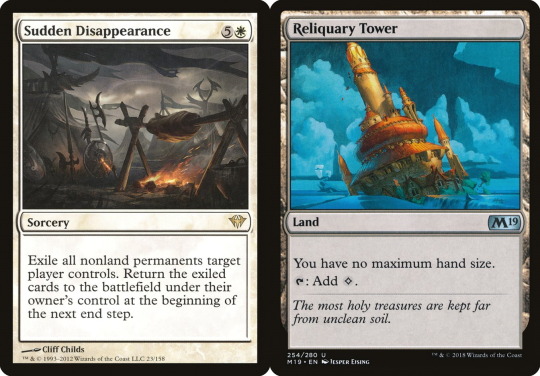
So now you’ve got your deck, you’ve mulliganed as you need, you’ve played an Island. I see you preparing to cast that Opt - but wait! Casting a spell is quite a bit more complex than it first seems, so let’s go over that now.
9. Casting Spells and Activating Abilities
All this time, I’ve been talking about casting and activating without really explaining exactly what that means, so now let’s make sure you know what that means. There is a lot of nuance to properly casting a spell, but once you understand it, you can ignore all the decorum in most cases. However, it’s still important to know exactly what happens to prevent common misunderstandings, and because Magic is full of strange cards that love to bend the rules; you will doubtless find fun corner cases.
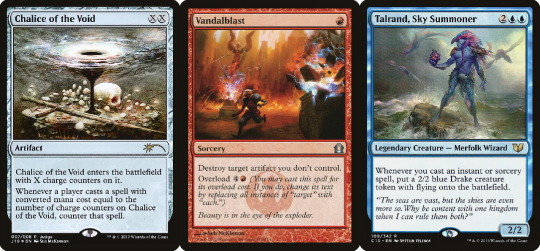

The steps to casting a spell and activating an ability are identical except the first, so I will be going over them together, referring to casting a spell.
Declare you are going to be casting the spell by putting it from where it is (generally, your hand) onto the stack. An ability will be put onto the stack as an arbitrary object.
Declare all the additional and alternative costs you wish to pay (for example, Vandalblast’s Overload cost), the mode of the card for split cards (such as Assure // Assemble) and double-faced cards (such as Alrund, who is also a bird on his other side!), and define the value of X (such as for Chalice of the Void), which you can pay for in mana of any color.
Choose the targets of your spell. You must have a legal target for each time the word “target” appears on the card (this is when effects such as “When this becomes the target of a spell” are triggered and go on the stack, to be sorted out and resolved later).
Now determine how much you need to pay. This includes cost reductions and additional costs, such as for Torgaar, as well as taxing effects (i.e., “noncreature spells cost {1} more to cast).
Activate mana abilities, such as those from your lands and mana rocks, and pay all costs as required. This means, for example, that you can tap a creature that produces mana and sacrifice it to pay for Torgaar.
Congratulations! Your spell or ability is now on the stack. Abilities that trigger while you are casting your spell, such as Talrand’s, will be on the stack above it and will thus resolve first. We covered fizzling before, but to clarify, a spell will fizzle only if all its targets are no longer legal, either through dying, or gaining Hexproof, or some other means. This means you get no part of its effects. If it has multiple targets, and only some become illegal, the card resolves as normal.
Like I said, you really don’t need to understand all of this in depth, but it helps clarify the occasional odd rules interaction.
10. Abilities
There are four types of abilities that you might find on cards. The one we’ve just covered extensively was activated abilities, which further come in two forms.
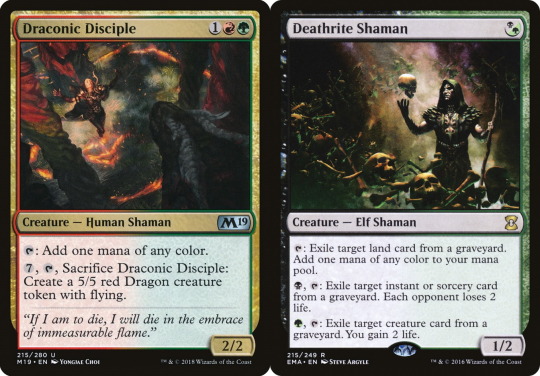
Draconic Disciple handily features both: a mana ability, and a normal activated ability. Notice that all activated abilities use the syntax “Cost X, Cost Y: Ability.” As we covered last chapter, you need to use mana abilities before paying costs when activating an ability, so you couldn’t tap Draconic Shaman for mana for his own ability as well as tap him to summon the dragon.
The main distinction for mana abilities is that they don’t use the stack, resolve instantly, and can be used while casting spells. An activated ability is considered a mana ability if and only if all it does is create mana. That means that Deathrite Shaman’s first ability is not a mana ability, because it exiles a land in addition to creating a mana.
The three other types of abilities are triggered abilities, passive abilities, and replacement effects.

Vanquisher’s Banner features a passive ability by giving all your creatures of a certain creature type +1/+1. It’s pretty straightforward: a static ability simply applies as long as the permanent which has it is on the battlefield. There are nuances in “layering”, but this is already far more complex than you’ll need to know for the majority of games. Feel free to read that article, though.
Vanquisher’s Banner’s third ability is a triggered ability - an ability that goes on the stack when something happens. This could be casting a spell, a creature entering the battlefield, or drawing a card - or just about anything. These are generally in the form “When” or “Whenever”, and should not be confused with replacement effects.
Replacement effects, like the one seen on Teferi’s Ageless Insight, come in the form “If... would... instead”. They are similar to triggered abilities in that they occur in response to something happening, but they don’t use the stack. Instead, think of them as modifiers to abilities. For example, if Teferi’s Ageless Insight was formatted like a triggered ability, drawing you a card each time you drew a card, you’d be stuck in an endless loop of drawing. Instead, replacement effects only apply once to each thing they modify.

There are many ways that abilities might manifest themselves, and they don’t always need to be on the battlefield. Bridge From Below’s wall of text works when it’s in the graveyard. Skyscribing’s ability only works from your hand, and is keyworded by Forecast, which only appeared in the original Ravnica set.
The best way to experience all the different interesting abilities and cards is just by playing and expanding your collection. Enjoy playing around and learning more about the game.
This is just about all you need to know to understand the game itself. However, Magic cards just love bending the rules, so you’ll always be encountering interesting rules interactions that will teach you more about the game as you play.
11. Formats
Here is where the fun really begins. Choosing a format is like choosing a social media platform: it comes with its own drama, flavor, speed, and player personalities. All formats use 60 card decks with 15 card sideboards, and start at 20 life, except Brawl and Commander. Each format has its own banlist, so make sure you check that before building just any deck. However, feel free to totally disregard all formats and just build whatever deck you want to have fun with friends!
Here are the most popular formats:
Standard: Probably the most popular 1v1 format, Standard uses cards from the last few sets, and constantly rotates. Deck prices can range from under 100$ to over 500$ when certain powerful cards are in rotation, but when a card rotates out, it can lose its value if it isn’t played in older formats. It can be competitive, but also lets you play with fun new cards in a weaker environment.
Pioneer: The newest official format, Pioneer uses cards dating back to the set Return to Ravnica. It has the same fresh feel as Standard, but doesn’t rotate and is closer in power level to Modern.
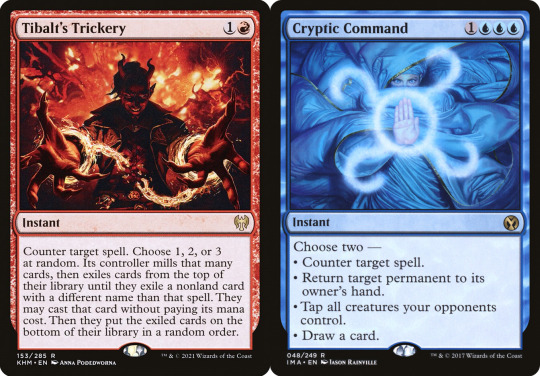
Modern: This format uses cards from the newest set all the way back to Eighth Edition from 2003. Decidedly more powerful than Standard, and expensive as well. Competitive decks can range from 200-1000$, but the vast size of the card pool means you can find budget builds and underdog decks to tinker with.
Legacy: You can use any card in the history of Magic, except those from the Banlist. The power level is incredibly high, yet the stereotype of 2-turn games is not as true as one might think. Because of the original dual lands, decks are often over 1000$, but mono-colored decks such as Burn can be brought down to 200$. Definitely not for the faint of heart.

Vintage: Like legacy, all cards are at your disposal, and this time, instead of a banlist, you have a restricted list, meaning you are limited to 1 copy of certain cards. A single copy of Black Lotus can be tens of thousands of dollars, and is a staple alongside the rest of the Power Nine. Very few play it because of the price tag, but it lets you tap into the true power of the oldest Magic cards.
Commander (AKA EDH): Play with any card, like Legacy, but with the distinct Commander banlist. The deckbuilding process here is very different: Pick a legendary creature you like, and pick 99 more cards that are of the same color(s) as your commander. This is a singleton format, meaning you can only have one of each card except for basic lands. Commander is also a multiplayer format, played in pods of 3-6; most often 4. Your commander starts in the Command Zone, where you can cast it. Each time it dies, it goes back to the Command Zone, where you can replay it for an additional 2 mana each time. The multiplayer nature, 40 starting life total, and high variance make Commander incredibly casual, much more a social event than a game. Have fun casting huge spells, playing pet cards, and embodying your commander. That being said, there’s a competitive scene in EDH, known as cEDH.
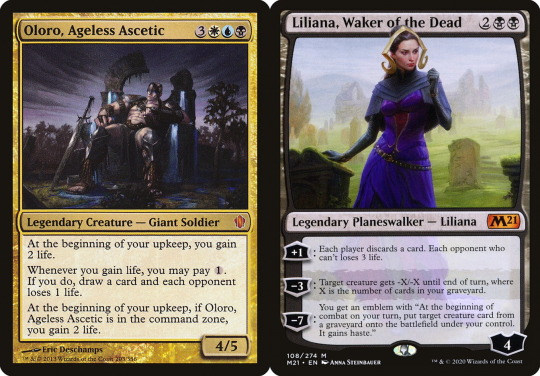
Brawl: Ah, Brawl. Commander’s younger, forgotten brother. It’s a cross between Commander and Standard, in which you have a commander (in this case, it can also be a planeswalker) and must have singleton copies of cards. Like Standard, you can only use cards from the last few sets, your deck is only 60 cards (no sideboard, though), and games are 1v1. You start with 25 life. Almost nobody plays this in person, but it’s very fun on MTG Arena.
12. Where to Play
Assuming you don’t have a group of friends ready to accept you into their playgroup, finding people to play with can be hard. First, I’d recommend checking Wizards of the Coast’s official Store Locator to find local game stores that might be hosting events and selling cards. If you go to their websites, they’ll often have calendars listing events by date, format, price, and prize. Explore and find one you like. MTG players are generally friendly, and will be willing to accept you into their playgroup, teach you about the game, and maybe even let you borrow a deck!
If you don’t feel like playing in person, there are several online options.
Magic Online (AKA MTGO or MODO) is the primary official way to play. Pay 10$ for an account, and you can buy, sell, and trade cards as if they were real. No really - Magic cards are almost like stocks, and MTGO cards are basically digital versions of Magic cards, so their price will generally mirror their real world counterparts, albeit at a lower price.
Magic Arena (MTGA) is the newest official online game. It only has cards from recent sets, back to Kaladesh, as well as a few odd cards hand-picked for Historic play (a format specific to the game that uses all cards available). Because of the smaller card pool, MTGA is limited to Standard, Brawl, and Historic as the primary game modes. However, it is free to play and your collection can’t be traded, so you collect cards somewhat like Hearthstone.
There are also a few unofficial programs, including Untap.in, XMage, and Cockatrice, which are free and give you access to the full range of cards for testing new decks before you buy them in paper.
Make sure you keep track of MagicFests, official conventions hosted both around the world and online, to meet tons of new people and play in competitive events.
Ultimately, though, many people choose to play at home around the kitchen table with friends and family. Play wherever and however you feel most comfortable; after all, Magic’s best aspect is self-expression.
13. Accessories

Credit: Tolarian Community College
If you’ve visited a local game store by now, you may have noticed that they sell way more than just cards. There are a myriad of accessories you can use to personalize your game and protect your cards.
Dice: from D4′s to D20′s, you can find these in countless colors and styles. Have fun picking your favorite and use them to keep track of life totals, counters, tokens, and more.
Sleeves: These can come in many different colors and designs, but vary wildly in quality. Pick the ones that feel right for you. These will help you shuffle your deck with ease and prevent your cards from getting damaged. Inner and outer sleeves provide additional protection for your most valuable and prized decks.
Deckboxes: Again, tons of variation. The right deckbox for you will depend on how many cards you want to fit in it, if you want space for dice, the design, and much more.
Playmats: These provide a sleek surface for you to easily pick up, tap, and move your cards around. Pick ones with your favorite Magic art, or order one with your own.
Trade Binders: Once you’ve built up a collection, you might have a few valuable cards you want to show off. Put them in a trade binder, and approach people to find other neat cards you might need.
Tolarian Community College on Youtube provides the best reviews of popular accessories, rating and testing them thoroughly. He also dishes out incredible commentary on new sets and the state of the game. Probably the most popular MTG Youtuber out there.
14. Further Resources
You’ve made it this far, but there’s still so much to explore! Here, I’ll be listing plenty of websites that are excellent resources to expand your understanding of the game.
The official rules: Quite dry, but this is where to go if you ever find a confusing interaction.
Tolarian Community College: I just discussed him, but I must reiterate how awesome his channel is.
Scryfall: A powerful search engine for all the Magic cards you might be looking for. What I’ve been using for card images this whole time. WOTC’s official Gatherer pales in comparison.
TCGPlayer: My favorite way to order cards online, but alternatives include Card Kingdom, StarCityGames, and ChannelFireball.
MTGGoldfish: An excellent all-round resource for keeping track of metagames, card prices, and interesting articles and gameplay. You can also use it to find, build, and share decks and see their prices.
EDHREC: This site conglomerates EDH decks from around the internet to give you a condensed list of the best cards by commander. A must-have resource when building new commander decks.
Last but not least, the best way to learn to play Magic is to watch others. I started out by watching gameplay from Grand Prix’s and other competitions on Youtube. Even though I barely knew what the cards were, I quickly picked up the most popular ones, learned common play patterns, and more. You don’t need to be a pro to learn from them.
15. Have Fun!
Yeah, it’s cheesy, but as I’ve reiterated, Magic is a game of self-expression. With thousands of cards to pick from, plenty of formats, styles, and accessories, customize your play experience as much as you want and be comfortable with that. Meet new people, participate in trading, and play in local events. Magic is what you make of it, so make it the best it can be.
30 notes
·
View notes
Text
Round of 1024 - Batch 4
Here is the fourth instalment in the Tournament of Champions! Once again we are looking for the greatest Legend in Magic: the Gathering.
You can vote here on hits such as Alesha, Isamaru, Urza, Krenko, Nicol Bolas, and even Richard Garfield himself.
Full list of matchups:
Tsabo Tavoc vs Gisela, the Broken Blade
Hixus, Prison Warden vs Grand Warlord Radha
Treva, the Renewer vs Mangara of Corondor
Akroma, Vision of Ixidor vs Ayli, Eternal Pilgrim
Braids, Conjurer Adept vs Infernal Kirin
Myojin of Seeing Winds vs Zetalpa, Primal Dawn
Alesha, Who Smiles at Death vs Sygg, River Cutthroat
Kari Zev, Skyship Raider vs Ertai, the Corrupted
Heidar, Rimewind Master vs Tarox Bladewing
Thassa, Deep-Dwelling vs Ob Nixilis, the Fallen
Nicol Bolas vs Damia, Sage of Stone
Obzedat, Ghost Council vs Emiel the Blessed
Sidisi, Brood Tyrant vs Kalitas, Traitor of Ghet
Urza, Lord High Artificer vs Lathiel, the Bounteous Dawn
Xun Yu, Wei Advisor vs Niv-Mizzet, Dracogenius
Zo-Zu the Punisher vs Michonne, Ruthless Survivor
Kodama of the South Tree vs Nekusar, the Mindrazer
Rashmi, Eternities Crafter vs Krenko, Mob Boss
Arixmethes, Slumbering Isle vs Rith, the Awakener
Chandra, Fire of Kaladesh vs Ib Halfheart, Goblin Tactician
Obeka, Brute Chronologist vs Animar, Soul of Elements
Archangel Avacyn vs Neheb, the Eternal
Isamaru, Hound of Konda vs Tahngarth, Talruum Hero
Nikara, Lair Scavenger vs Vial Smasher the Fierce
Crovax the Cursed vs Rakdos, the Showstopper
Anafenza, Kin-Tree Spirit vs Kroxa, Titan of Death's Hunger
Yuan Shao, the Indecisive vs Gadrak, the Crown-Scourge
Adeliz, the Cinder Wind vs Keruga, the Macrosage
Snapdax, Apex of the Hunt vs Ghalta, Primal Hunger
Grandmother Sengir vs Teshar, Ancestor's Apostle
Richard Garfield, Ph.D. vs Marisi, Breaker of the Coil
The Scorpion God vs Etrata, the Silencer
29 notes
·
View notes
Text
Decks lists on demand
Wrexail the risen deep black blue let's cast all the things
Odric, master tactician (captain no blocks)
Yisan the wandering bard (green goodies)
Krenko mob boss (goblins for everyone)
Bosh the iron golem. ( mr burning up)
Ezi.. claws of progress (I spelled him wrong. But my one one is now 30/30)
Azami , lady of scrolls. ( krackens with wizard hats)
Isareth the awakener (black never say die... wait yes the do)
Sidisi, brood tyrant ( Cause this is Thriller!)
Wort, the Raidmother(dance dance muilty cast elements)
Gwafa Hazid, Profiteer. (Pillofort.. or why dont you attack someone else and how I learned it pays to profit)
Daxos The Returned (friend of enchantments )
Yennett cryptic sovereign. (Sphinx sirprises)
Ghave, guru of Spores (a really funguy) punny is it not
Dragon lord dromoka. (Fight club)
ZEDRUU. (GIFTING THE AMERICAN WAY OR MUILTI CASTING )
Astrid the masked ( out of the box enchanting)
Brudiclad, telchor engineer ( get in the mecha shingi)
Gshath, Sun's avatar (*Jurassic park theme song plays*)
Grenzo, dungeon warden ( knock knock heroes Rackdos)
Jor Kadeen, the Prevailer. ( harder better fast stronger Zakooooo)
Arahbo roar of the world. (Cats cats cats)
Spiders under construction no set commander yet.
62 notes
·
View notes
Note
How many edh decks do you have/ what are the commanders?
MY CHILDREN
I keep 50 boxes/sleeves and that is my max, they arent always full. Some decks feel like fads, some stick with me over time.
Oketra the True - monoW catmom EDH
Sai, Master Thopterist - monoU thopter/artificer
Unesh, Criosphinx Sovereign - monoU sphinx tribal
Ayara First of Locthwain - monoB attrition
Daretti, Scrap Savant - monoR artificer
Lathliss, Dragon Queen - monoR dragons
Oviya Pashiri, Sage Lifecrafter - monoG wide n tall
Grothama, All-Devouring - monoG stompy wurms
Gisa and Geralf - dimir zombie tribal
Lazav, Dimir Mastermind - dimir mill
Saheeli, the Gifted - izzet X-ers
Jori En, Ruin Diver - izzet cantrips
Eutropia the Twice-Favored - simic Ancient Wood constellation
Tajic, Blade of the Legion - Boros Damage Control
Obzedat, Ghost Council - orzhov life attrition
Anje Falkerath - rakdos madness reanimator
Borborygmos Enraged - gruul landfall
Aminatou, the Fateshifter - esper topdeck
Alela, Artful Provocateur - esper faerie trickery
Kess, Dissident Mage - grixis bolas manipulation
Ghired, Conclave Exile - naya tokens
Marisi, Breaker of the Coil - naya goad
Riku of Two Reflections - temur hug
Haldan, Avid Arcanis (U)/Pako, Arcane Retriever (RG) - temur topdecking
Sidisi, Brood Tyrant - sultai self mill
Otrimi, the Ever-Playful - sultai mutate
Korvod, Fae-Cursed King - jund devour
Doran, the Siege Tower - abzan toughness matters
Kathril, Aspect Warper - abzan keyword soup
Sevinne, the Chronoclasm - jeskai flashback
Elsha of the Infinite - jeskai combat control
Roon of the Hidden Realm - bant flicker
Kestia, the Cultivator - bant auras
Golos, Tireless Pilgrim - 5c casting matters
Horde of Notions - 5c elemental tribal
Kenrith, the Returned King - 5c edict EDH
The Ur-Dragon - 5c dragons
O-Kagachi, Vengeful Kami - 5c gifted deck
-OPEN SLOT-
-OPEN SLOT-
13 notes
·
View notes